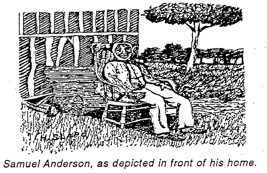Samuel Anderson: The Last Flatbush Slave
Augustus W. Harris
Samuel Anderson, my great-great-grandfather, was born 17 February 1813 at Jeremiah Lott’s farm, on Flatbush Avenue near Cortelyou Road. His mother was Isabella Butler, a slave in Jeremiah Lott’s house, while his father, Samuel Anderson, was owned by Richard Remsen.
In 1813, Flatbush Town, a small farming community, was the leading center for slave holding in Kings County. Seventy-three percent of its households owned at least one slave and over sixty percent owned five or more slaves. The average per household was 5.7 slaves.

Stories about Flatbush farm life say the farms produced almost everything they needed, including supplies, clothing and food. Farmers divided the work by gender and everyone (slaves, owners, and bond servants) shared the chores.
Men collected timber, cultivated and harvested crops, tended animals, hunted, and mended tools. Women were responsible for the domestic work, including cooking, sewing, washing, ironing, soap and candle making, egg gathering, and taking care of poultry. Slaves, both male and female, were also responsible for tending the fireplace, cleaning the chimney, and slaughtering animals.
When asked about the old Flatbush, Samuel described his religious experiences. Evidently, he started going to church at an early age. “I attended services in the old Flatbush Dutch Reformed Church regularly and occupied a seat in the gallery, the men on one side and the women on the other. I remember well Dominie Schoonmaker’s Dutch Sermon, and I also remember John Antonidas, who was sexton, chorister and grave digger. It was also his duty to go around to give death notices and invite relations and friends to the funeral services.”
In cold weather, two iron stoves heated the church. Each pew contained a foot stove (perforated wood or tin boxes, about 12 inches long). Young servants, such as Samuel, traveled to church with the family and tended the stoves, keeping them filled with hot hickory coals.
Around 1832, Samuel joined the African Wesleyan Methodist Episcopal Church, also known as Bridge Street AWME, in downtown Brooklyn (then a separate town). To get to church, Samuel walked over four miles, traveling through the woods, through what is now Prospect Park.
“There was a stage line at that time from Flatbush to Fulton Ferry, but money was scarce with me, and although it took longer, it was much cheaper to walk. On very rare occasions, I would take a ride on the stage. Colored people had to sit on the top, the inside being reserved for white folks.” The stage coach started in New Utrecht, traveled over Church Avenue to Flatbush, exchanged mail bags and passengers, and then continued to Brooklyn.
On Sundays, Samuel usually made several trips to church! He attended the morning, afternoon and night services, but had to return home at noon and in the evening to complete chores. Several years later, he began attending the “Church in The Woods,” a Flatbush branch established by Bridge Street AWME Church for its growing membership.
Describing his church activities, Samuel said: “I was for a time an exhorter, a local preacher, and active in the High Street Church. Then I became interested in our little Flatbush church. We had great revivals in those days and the building was packed Sunday after Sunday.
Samuel married Martha Pryor and they had twelve children. Existing records list eight of their children: Francis, Jane, Martha, Isabella, George, Samuel, Mary, and Joshua. They lived in a small two-story cottage painted white and covered with ivy. Located in Flatbush’s southeastern section, the cottage was near the “Church in the Woods.”
Samuel was an excellent gardener, encircling the house with flowers in the front yard and a vegetable garden in the back. Eggs from his flock of chickens raised a modest income. Samuel was well-known in Flatbush. As he walked around town selling his eggs, people warmly greeted him.
About 1895, a Flatbush historian interviewed Samuel, then considered the last Flatbush slave. He described Samuel as a short colored man with white hair. Although bent with age, he was spry for a man who worked so hard during his life. Samuel was intelligent, had a warm personality, and preferred to talk about religion.
When the interview ended, Samuel turned his face and hand upward in prayer and said: “But it is now all past, and I am just waiting, waiting to be called to Glory.” Samuel moved to Brooklyn’s Home for the Aged and lived there until his death, 17 September 1903.
_______________
Reprinted from the AAHGS Jean Sampson Scott Greater New York Chapter Newsletter, Fall 1995, p. 1-3.